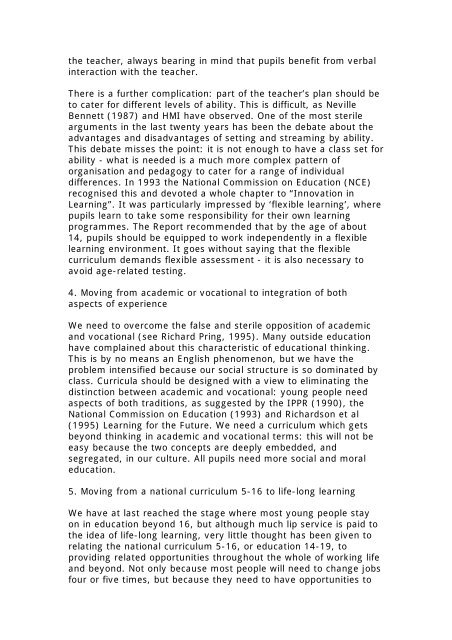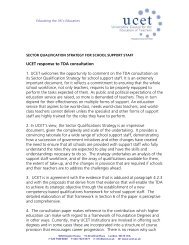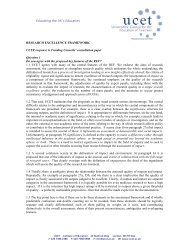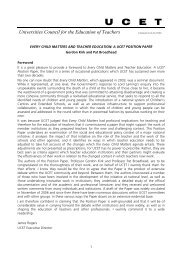The School Curriculum Ten Years Hence - UCET: Universities ...
The School Curriculum Ten Years Hence - UCET: Universities ...
The School Curriculum Ten Years Hence - UCET: Universities ...
Create successful ePaper yourself
Turn your PDF publications into a flip-book with our unique Google optimized e-Paper software.
the teacher, always bearing in mind that pupils benefit from verbal<br />
interaction with the teacher.<br />
<strong>The</strong>re is a further complication: part of the teacher’s plan should be<br />
to cater for different levels of ability. This is difficult, as Neville<br />
Bennett (1987) and HMI have observed. One of the most sterile<br />
arguments in the last twenty years has been the debate about the<br />
advantages and disadvantages of setting and streaming by ability.<br />
This debate misses the point: it is not enough to have a class set for<br />
ability - what is needed is a much more complex pattern of<br />
organisation and pedagogy to cater for a range of individual<br />
differences. In 1993 the National Commission on Education (NCE)<br />
recognised this and devoted a whole chapter to “Innovation in<br />
Learning”. It was particularly impressed by ‘flexible learning’, where<br />
pupils learn to take some responsibility for their own learning<br />
programmes. <strong>The</strong> Report recommended that by the age of about<br />
14, pupils should be equipped to work independently in a flexible<br />
learning environment. It goes without saying that the flexible<br />
curriculum demands flexible assessment - it is also necessary to<br />
avoid age-related testing.<br />
4. Moving from academic or vocational to integration of both<br />
aspects of experience<br />
We need to overcome the false and sterile opposition of academic<br />
and vocational (see Richard Pring, 1995). Many outside education<br />
have complained about this characteristic of educational thinking.<br />
This is by no means an English phenomenon, but we have the<br />
problem intensified because our social structure is so dominated by<br />
class. Curricula should be designed with a view to eliminating the<br />
distinction between academic and vocational: young people need<br />
aspects of both traditions, as suggested by the IPPR (1990), the<br />
National Commission on Education (1993) and Richardson et al<br />
(1995) Learning for the Future. We need a curriculum which gets<br />
beyond thinking in academic and vocational terms: this will not be<br />
easy because the two concepts are deeply embedded, and<br />
segregated, in our culture. All pupils need more social and moral<br />
education.<br />
5. Moving from a national curriculum 5-16 to life-long learning<br />
We have at last reached the stage where most young people stay<br />
on in education beyond 16, but although much lip service is paid to<br />
the idea of life-long learning, very little thought has been given to<br />
relating the national curriculum 5-16, or education 14-19, to<br />
providing related opportunities throughout the whole of working life<br />
and beyond. Not only because most people will need to change jobs<br />
four or five times, but because they need to have opportunities to






